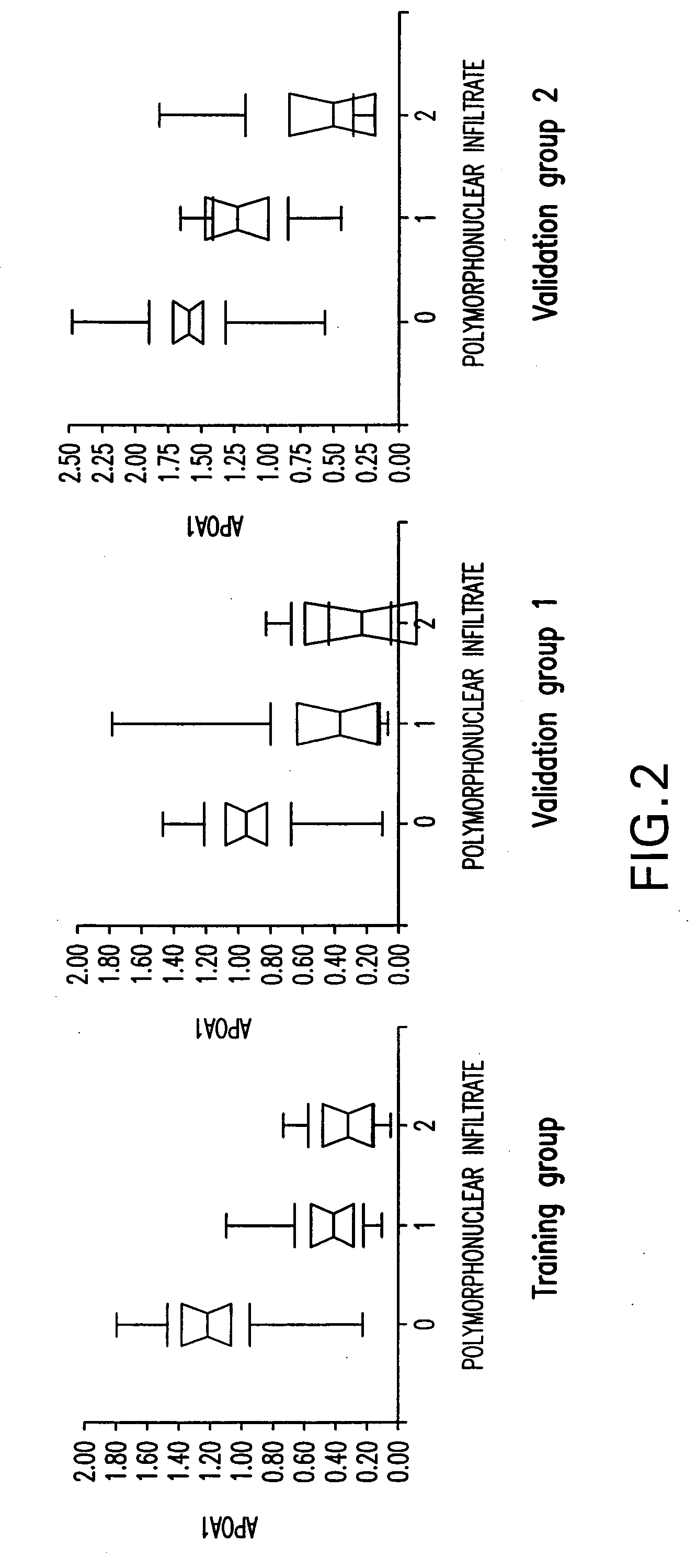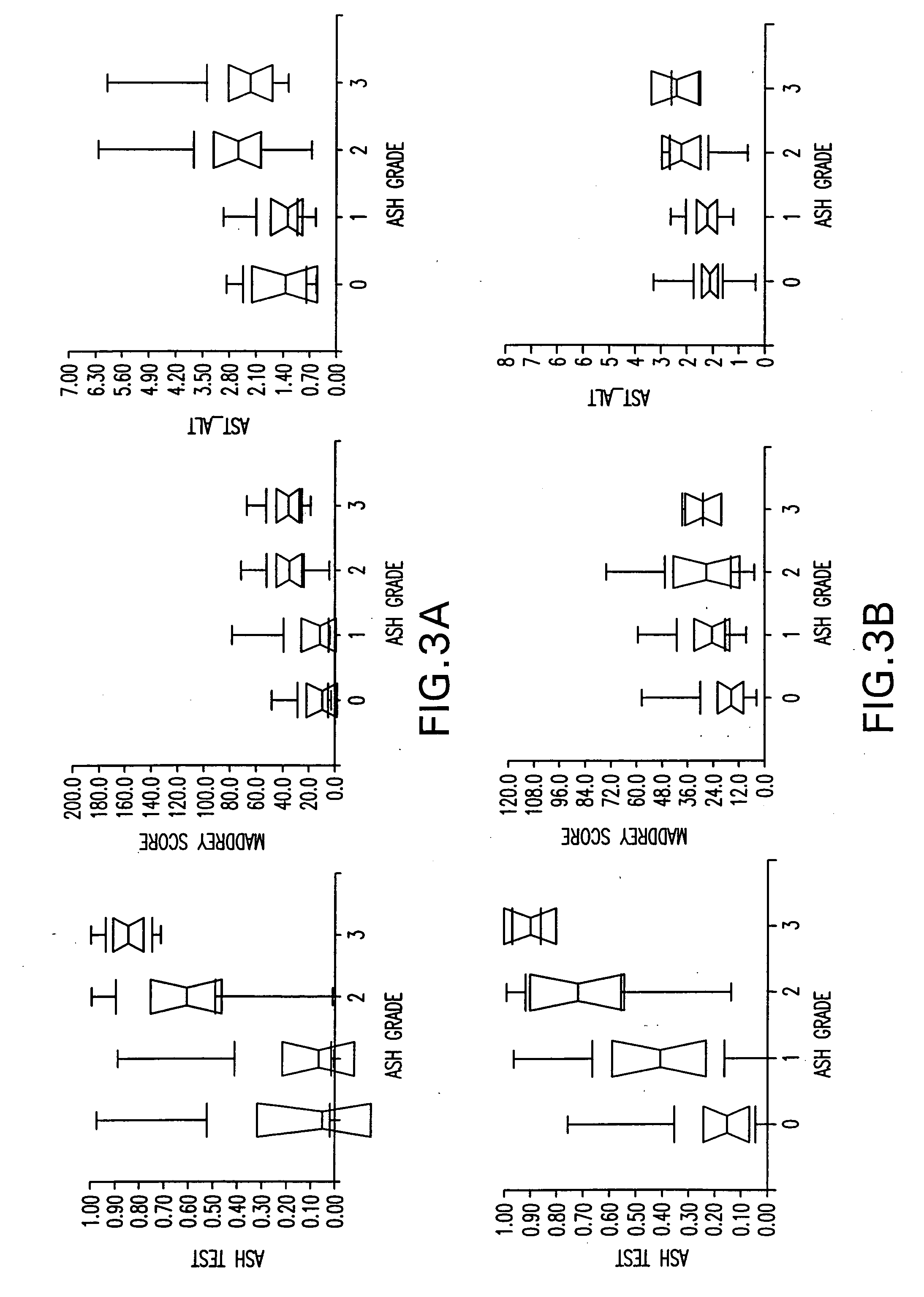Diagnosis method of alcholic or non-alcoholic steato-hepatitis using biochemical markers
a technology of steato-hepatitis and biochemical markers, which is applied in the field of diagnosis of alcholic or non-alcoholic steato-hepatitis using biochemical markers, can solve the problems of liver transplantation and death, no study has really identified an accurate combination of ash markers, and no such diagnosis test is currently available for the more precise diagnosis of ash markers, so as to reduce the number of biopsy indications and reduce the risk of liver biopsies. ,
- Summary
- Abstract
- Description
- Claims
- Application Information
AI Technical Summary
Benefits of technology
Problems solved by technology
Method used
Image
Examples
example 1
Patients and Methods
1.1. Patients
[0079] Patients with heavy alcohol consumption, available serum and a consistent liver biopsy were included (FIG. 1). The criteria of inclusion was that all included patients had a self-reported daily alcohol consumption equivalent to at least 50 gm of pure ethanol during the preceding year, with a mean of 146 (se=80) gmn per day for 17 years. The patient's families were also interviewed, when possible. All patients gave informed consent for the use of data and serum for research purposes. Non-inclusion criteria included concomitant liver diseases (the presence of HCV antibodies or HBs antigen, hemochiromatosis, cholestatic disease, autoimmune disease), HIV antibodies and Immunosuppression, non-available serum, non-available biopsies and patients for whom biopsy and serum were collected more than one month apart.
[0080] The analysis was performed on a first group (training group) and validated on 2 different groups (validation groups).
[0081] Tra...
example 2
[0097] Statistical analysis used Fisher's exact test, the chi-square test, Student's t test, the Mann-Whitney test and variance analysis using the Bonferroni all-pair wise and Tukey-Kramer multiple-comparison tests to take into account the multiple comparisons and multiple logistic regression for multivariate analysis. The analysis was performed on a first group (training group) and validated on 2 different groups (validation groups 1 and 2), in cohorts of patients as in Table 1.
[0098] According to the ASH scoring system, patients were divided into several groups.
[0099] The primary outcome was the identification of patients with alcoholic hepatitis (mild, moderate or severe).
[0100] In a secondary analysis, patients were classified according to the presence of each elementary feature of alcoholic hepatitis and according to a 4 scale scoring system.
[0101] The first stage consisted of identifying factors which differed significantly between these groups by uni...
example 3
Determination of the Logistic Function
[0108] The AshTest score is defined as the logistic regression function combining the independent factors that returns the best index in term of discrimination between the presence or absence of ASH.
[0109] In Table 2 are given the characteristics of patients according to the presence of alcoholic steato-hepatitis for each of the seven biochemical markers, the AST / ALT ratio, the Maddrey function, the FibroTest score, the ActiTest score, and the AshTest score, as well as their independent association with fibrosis (P value).
TABLE 2Characteristics of patients according to the presence of alcoholic hepatitisAlcoholic hepatitisIn the training groupAlcoholic hepatitisAlcoholic hepatitisNo n = 28In the Validation group 1In the Validation group 2Characteristicm (SD)Yes n = 42P valueNo n = 50Yes n = 12P valueNo n = 71Yes n = 22P valueDemographicsAge at biopsy,53.9(11.2)53.4(10.7)0.6655.2(7.2)47.8(8.3)0.00546.3(10.2)50.5(11.5)0.22yearsMale gender25(8...
PUM
 Login to View More
Login to View More Abstract
Description
Claims
Application Information
 Login to View More
Login to View More - R&D
- Intellectual Property
- Life Sciences
- Materials
- Tech Scout
- Unparalleled Data Quality
- Higher Quality Content
- 60% Fewer Hallucinations
Browse by: Latest US Patents, China's latest patents, Technical Efficacy Thesaurus, Application Domain, Technology Topic, Popular Technical Reports.
© 2025 PatSnap. All rights reserved.Legal|Privacy policy|Modern Slavery Act Transparency Statement|Sitemap|About US| Contact US: help@patsnap.com



